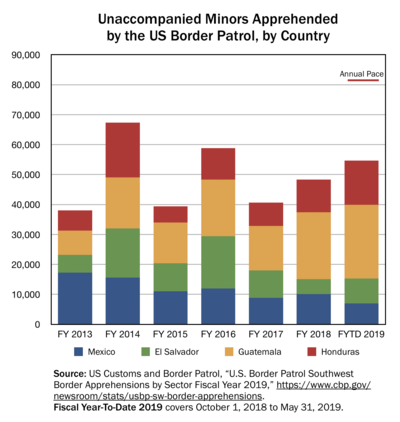
Unaccompanied Alien Children (or UAC, also referred to as unaccompanied alien minors[1] or UAMs[2]) is a United States government classification for children in immigration custody and the name of a program operated by the Office of Refugee Resettlement (ORR; a division of the United States Department of Health and Human Services, HHS) to house and care for them.[3] The term designates unaccompanied minors who are aliens, typically those who have been apprehended outside of a legal port of entry or judged inadmissible[4] upon their entry.
The phrase "unaccompanied alien children" was first used in the Homeland Security Act of 2002.[5] HHS defines "unaccompanied child" (UC) as a person "who has no lawful immigration status in the United States; has not attained 18 years of age, and with respect to whom; 1) there is no parent or legal guardian in the United States; or 2) no parent of legal guardian in the United States is available to provide care and physical custody."[6]
However, the practice of the Department of Homeland Security is to only define children traveling with their parents or legal guardians as part of "family units" and all other children as "unaccompanied minors."[5] As a result, children traveling with grandparents, adult siblings, and aunts and uncles are referred to the UAC program.[5] Children separated from their parents under the Trump administration's family separation policy were referred to the UAC program.[7]
ORR's Unaccompanied Alien Children Program began in 2003 and housed fewer than 8,000 children per year through 2011.[3] Significant increases in the population occurred during crises in 2014, 2016, 2019, and 2020–21 all driven by a surge in unaccompanied migrants fleeing violence and poverty in the Northern Triangle of Central America.[3][8][9] In fiscal year 2018, 49,100 children were referred to the UAC program, an average of 135 per day.[3] This rate has since increased, and reached 287 daily referrals in April 2019.[3] In April 2019, an average of 12,587 children were housed in the program, which then had a capacity of 14,363 beds.[3] In April 2021, amid a renewed surge in unaccompanied minor migrants, more than 17,000 children were housed in HHS shelters, a number above the department's capacity.[9]
Customs and Border Patrol (CBP), an agency of the Department of Homeland Security, holds unaccompanied children after their initial arrest. CBP is legally obligated to refer them to the ORR's UAC program within 72 hours, but in 2019, such children are being for weeks or months in CBP custody.[10] On June 13, 2019, the government reported that 2,081 UAC were held by the CBP;[10] in late June, a CBP official stated that the number had been reduced to less than 1,000.[11]
- ^ "Remarks by President Trump at Cabinet Meeting". whitehouse.gov. 21 June 2018 – via National Archives.
Since 2014 alone, nearly 200,000 unaccompanied alien minors have been released into the United States pending their immigration court proceedings as required under the Immigration and Naturalization Act and related laws and court orders
- ^ "IRLI Obtains from ICE through FOIA Taxpayer Costs Regarding the Unaccompanied Alien Minor Crisis". Immigration Reform Law Institute. 21 August 2015.
the unaccompanied alien minor (UAM or UAC) crisis .. education of UAMs resettled
- ^ a b c d e f US Department of Health and Human Services. Assistant Secretary for Public Affairs (ASPA) (2019-05-02). "Latest UAC Data – FY2019". HHS.gov. Retrieved 2019-06-26.
- ^ "Southwest Border Inadmissibles by Field Office FY2018".
Southwest Border Unaccompanied Alien Children (0-17 yr old) Inadmissibles
- ^ a b c Burnett, John (December 23, 2018). "What 'Unaccompanied Alien Children' Means". NPR.org. Retrieved 2019-06-26.
- ^ "Who We Serve - Unaccompanied Children". hhs.gov. March 26, 2021.
- ^ Cite error: The named reference
:4was invoked but never defined (see the help page). - ^ Marc R. Rosenblum & Isabel Ball, Fact Sheet: Trends in Unaccompanied Child and Family Migration from Central America, Migration Policy Institute (January 2016).
- ^ a b Michael D. Shear, Zolan Kanno-Youngs and Eileen Sullivan, Young Migrants Crowd Shelters, Posing Test for Biden, New York Times (April 10, 2021).
- ^ a b Lind, Dara (2019-06-25). "The horrifying conditions facing kids in border detention, explained". Vox. Retrieved 2019-06-26.
- ^ Cite error: The named reference
:6was invoked but never defined (see the help page).